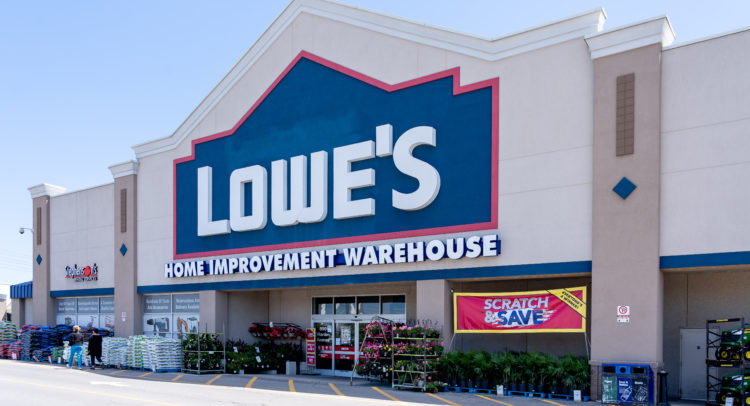Lowe’s Companies (NYSE:LOW) has started to look attractive lately, as shares are down substantially year-to-date. With quality companies like Lowe’s rarely going on sale, investors, especially dividend-oriented ones, are likely to view this as an opportunity. However, Lowe’s earnings may peak this year, as growth could be impacted by many macroeconomic factors over the next couple of years. Accordingly, I am neutral on the stock.
Why Income-Oriented Investors May Find LOW Stock Attractive
Lowe’s has historically appealed to income-oriented investors due to the company’s business model and market dominance, having proven its ability to drive robust earnings and dividends over time. For context, Lowe’s is the second-largest home improvement retailer in the States, only after Home Depot (NYSE:HD). The two companies know the market is big enough for both of them and don’t engage in brutal pricing wars. Hence, they have both managed to grow at a steady pace.
This is reflected in the company’s financials and, most importantly, in Lowe’s dividends, as reflected in its Dividend King status. This term is often unofficially stated by investors to define these companies which have raised their dividends annually for 50 or more successive years.
With the company now boasting 60 years of successive dividend increases, it’s no surprise the stock is so often praised by dividend growth and income-oriented investors. Adding to this is the fact that dividend growth has accelerated considerably over the past few years.
Specifically, after Lowe’s 33.3% dividend-per-share hike in May of 2021, another equally impressive hike of 31.3% followed this past May. These make for the chubbiest increases in 15 years. In my view, the reason lies behind management’s intention to maintain a robust income-oriented shareholder base in a treacherous macroeconomic landscape. This could prove to be a potent catalyst that would help the stock outperform its peers during times of increased volatility. Still, that’s speculation.

Another reason to like Lowe’s dividend growth prospects is that despite the two most recent massive dividend hikes, Lowe’s payout ratio stands at just 31.1%, based on consensus EPS estimates of $13.50 for Fiscal Year 2022. This implies that there is ample room ahead for management to increase investor interest in the stock through further substantial hikes.
Are Lowe’s Results Peaking This Year?
Lowe’s dividend growth prospects appear attractive, but ultimately, the company’s ability to increase payouts lies in its ability to grow profits. Could this be achieved over the long run? Quite possibly. Still, Lowe’s results could peak this year, and net income may fail to grow in the coming years as a result of multiple macro uncertainties. Regardless, the company’s most recent results were rather decent.
In its Q2 results, Lowe’s posted total sales of $27.5 billion compared to $27.6 billion in the prior-year period, with comparable sales falling 0.3%. Specifically, comparable sales for the U.S. Home Improvement division slipped 0.2%, year-over-year.
One argument to be made here is that the timing of Spring disproportionately affected the company’s DIY sales as several seasonal categories, such as lawn and garden, are mostly concentrated in DIY. In addition to Spring arriving late, it also ended early this year, moving from a cold winter to a hot summer very rapidly in some areas. This resulted in a compressed planting season that negatively impacted lawn and garden sales.
However, softened sales are likely also reflecting reduced consumer interest in home-improvement products as demand peaked last year due to the notable boost it got from the working-from-economy last year.
While sales came in rather soft, operating income came in at $4.2 billion, suggesting an operating margin rate of 15.39%, an improvement from 14.7% last year. However, this was due to the company lowering its selling, general, and administrative expenses, as gross margins fell slightly.
For the full year, management targets an operating margin of 12.8% to 13.0% and diluted earnings-per-share of $13.10 to $13.60. The midpoint of $13.35, which is actually lower than consensus EPS estimates, implies year-over-year growth of 10.8%. However, what the market is essentially pricing in considering the stock’s decline, is that Lowe’s earnings will peak this year.
With inflation raging, interest rate hikes becoming more aggressive, Europe likely to enter a heavy recession, and geopolitical uncertainty increasing by the day, consumers’ purchasing power is expected to decline. In fact, due to multiple negative factors, Lowe’s earnings may not see new highs in the next couple of years, which changes how investors price the stock substantially.
Is LOW Stock Attractively Priced?
Lowe’s is currently trading at around 15.2 times the midpoint of management’s earnings-per-share outlook for this year. The valuation appears below the stock’s 5-year average range of between 16 and 20, which may signal a buying opportunity.
This is entirely dependent, however, on Lowe’s earnings growth prospects. If the market is indeed pricing a stagnation in the bottom line over the next couple of years, then the softer multiple is well-justified. In that regard, I would suggest that investors buy into the current multiple only if they believe Lowe’s will surprise the market positively in the coming quarters.
Is LOW Stock a Buy?
As far as Wall Street’s sentiment goes, Lowe’s has a Strong Buy consensus rating based on 15 Buys and five Holds assigned in the past three months. At $241.35, the average Lowe’s stock forecast implies 19.3% upside potential.

Conclusion – LOW Stock is Solid, but Valuation Might be Justified
Lowe’s is a solid company with a decades-long track record of creating value for shareholders. Considering the stock’s decline, dividend-growth investors may find the stock’s current levels ideal for initiating a position. However, Lowe’s valuation must be simultaneously taken with a grain of salt, as its earnings may well have peaked this year. Thus, there may be limited upside ahead for the stock over the next several quarters.









